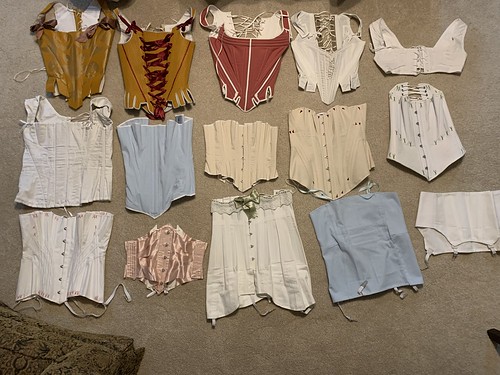Unexpected Progress
Apr. 30th, 2024 07:22 pmI ended up sewing more over the weekend than I really felt justified in. I got other stuff done too, but there's still a list. (Of course, there will always be a list because there will always be little stuff that would be better done.)
That being said, I finished the 1826 promenade dress. I was pleased to see that the weight of the flounces does indeed make the hem hang nicely with the padding in it.

It's a green wool with bodice and sleeves lined in linen. I put a layer of silk organza in the tops of the sleeves, but it still doesn't provide enough loft. The wool has lots of drape to it, which I like but is less than ideal for these sleeves. I tried it on with the 1830's sleeve puffs, but they're too big and stuff the sleeves full. I'll need to do something to support them a bit, but I need to figure out what. The Lady's Stratagem was no help. (To be fair, it's like 600 pages long, and I only looked at the index and flipped through a few other pages so there could be something I didn't see.)
Today I realized that I made a smock for the late 16th century/early 17th century a few years ago. Since body linens were mostly unchanged for ages and ages, a 14th century smock should be very, very similar to a 16th century one. I used a pattern from The Tudor Tailor so it really is probably meant for the 15th-16th centuries. It's also really similar to the instructions from The Medieval Tailor's Assistant so I feel like I'm on very stable ground not making a new one.
Between finishing the dress and not needing to make a smock, my Costume College list is in better shape. I still want bathing shoes (started), a 14th century gown, a wimple, a veil, and a 1930's dress, but that's a much more achievable list.
That being said, I finished the 1826 promenade dress. I was pleased to see that the weight of the flounces does indeed make the hem hang nicely with the padding in it.

It's a green wool with bodice and sleeves lined in linen. I put a layer of silk organza in the tops of the sleeves, but it still doesn't provide enough loft. The wool has lots of drape to it, which I like but is less than ideal for these sleeves. I tried it on with the 1830's sleeve puffs, but they're too big and stuff the sleeves full. I'll need to do something to support them a bit, but I need to figure out what. The Lady's Stratagem was no help. (To be fair, it's like 600 pages long, and I only looked at the index and flipped through a few other pages so there could be something I didn't see.)
Today I realized that I made a smock for the late 16th century/early 17th century a few years ago. Since body linens were mostly unchanged for ages and ages, a 14th century smock should be very, very similar to a 16th century one. I used a pattern from The Tudor Tailor so it really is probably meant for the 15th-16th centuries. It's also really similar to the instructions from The Medieval Tailor's Assistant so I feel like I'm on very stable ground not making a new one.
Between finishing the dress and not needing to make a smock, my Costume College list is in better shape. I still want bathing shoes (started), a 14th century gown, a wimple, a veil, and a 1930's dress, but that's a much more achievable list.



















